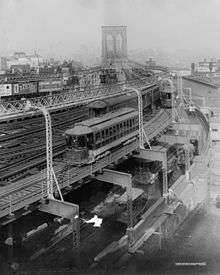Frederick W. Wurster
Frederick W. Wurster (April 1, 1850 – June 24, 1917)[1] was a Republican who served as the last mayor of Brooklyn (1896–97) prior to the January 1, 1898 consolidation into New York City.[2]

Early life and business
Wurster was born in Plymouth, North Carolina in 1850 to German immigrants.[3] At age 7, his family moved to Brooklyn and attended Public School No. 16. He later went to work at his father's iron and spring factory.[4] Eventually he had his own spring and axle factory on Kent Street and an iron foundry, and he also became involved in the banking industry.[3]
Politics

Wurster was not active in politics until his predecessor as mayor Charles A. Schieren appointed him Fire Commissioner.[4] He defeated Democrat Edward M. Grout (who would become Brooklyn's first Borough president in 1898) in a close mayoral election of November 1895.[5] As Wurster took office in January 1896, the City of Brooklyn's expansion to encompass all of Kings County was completed with the annexation of Flatlands.[6]
The Brooklyn Eagle obituary of Wurster described his administration "as precisely what might have been expected from a straightforward business man of good judgment, who had never had any training to develop political initiative. He dealt with matters as they came up and he was both conservative and energetic in his objection to wasting the city's money."[7] Wurster opposed consolidation with New York City, but believed it was inevitable, and as mayor supported a plan to have trolley cars installed on the Brooklyn Bridge. The first trolley crossed on the evening of December 31, 1897, a few hours before the City of Brooklyn ceased to exist, with Wurster on board.[8]
When consolidation occurred, Wurster addressed a reception at Brooklyn City Hall and commented: "We have come to the time of the passing away of this great city .... To some this may appear a mournful occasion, to others it may appear all for the best, but all owe it to the memory of the City of Brooklyn to make the borough of Brooklyn grow great ..."[9] After leaving office, he returned to his business interests.[8]
Personal and death
Wurster married Emily Scheig in 1874, and they built a house at 170 Rodney Street. The couple had six children. Subsequent to his first wife's death in 1899,[10] he married Annie D. Hoffman in 1904.[7][11]
Ill from strokes suffered in the prior year, Wurster died at his summer home in Belgrade Lakes, Maine on June 24, 1917.[4][7]
| Political offices | ||
|---|---|---|
| Preceded by Charles A. Schieren |
Mayor of Brooklyn 1896–1897 |
Succeeded by None |
References
- "Mrs. Frederick Wurster: Widow of Last Mayor of Brooklyn Dies at Her Home at 75". The New York Times. July 20, 1937.
- "Brooklyn's New Mayor" (PDF). The New York Times. January 2, 1896.
- "Candidates in Brooklyn" (PDF). The New York Times. November 7, 1895.
- "Frederick W. Wurster Dies: Last Mayor of Brooklyn Was a Manufacturer and Banker" (PDF). The New York Times. June 26, 1917.
- "Want An Official Count" (PDF). The New York Times. November 9, 1895.
- "Brooklyn's New Year" (PDF). The New York Times. January 1, 1896.
- "F.W. Wurster Dies; Brooklyn Ex-Mayor Victim of Stroke". Brooklyn Eagle. June 25, 1917. p. 1.
- Weyrauch, Martin H., ed. (1916). The Pictorial History of Brooklyn. The Brooklyn Daily Eagle. p. 94.
- "Rockets' Red Glare Marked Birth of Merged City in 1898". The New York Times. January 1, 1973. p. 33.
- "Mrs. F.W. Wurster Dead". Brooklyn Eagle. April 18, 1899. p. 3.
- "Ex-Mayor Wurster Weds". Brooklyn Eagle. June 15, 1904.